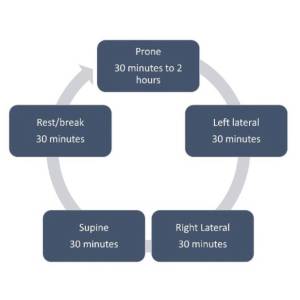Effectiveness of early awake self proning strategy in non-intubated patients with COVID-19 hypoxemia: an open-labelled randomized clinical trial from Jodhpur, India

Submitted: September 9, 2022
Accepted: December 5, 2022
Published: December 16, 2022
Accepted: December 5, 2022
Abstract Views: 1501
PDF: 396
Supplementary: 132
Supplementary 2_Ethics-Trial: 90
Supplementary 3-CONSORT Checklist: 127
Supplementary 4-Ministry of Health and Family Welfare handout: 91
Supplementary: 132
Supplementary 2_Ethics-Trial: 90
Supplementary 3-CONSORT Checklist: 127
Supplementary 4-Ministry of Health and Family Welfare handout: 91
Publisher's note
All claims expressed in this article are solely those of the authors and do not necessarily represent those of their affiliated organizations, or those of the publisher, the editors and the reviewers. Any product that may be evaluated in this article or claim that may be made by its manufacturer is not guaranteed or endorsed by the publisher.
All claims expressed in this article are solely those of the authors and do not necessarily represent those of their affiliated organizations, or those of the publisher, the editors and the reviewers. Any product that may be evaluated in this article or claim that may be made by its manufacturer is not guaranteed or endorsed by the publisher.
Similar Articles
- Valeriu Plesca, Ana Ciobanu, Yuliia Sereda, Andrei Dadu, Do catastrophic costs impact treatment outcomes in people with rifampicin-resistant tuberculosis in the Republic of Moldova? , Monaldi Archives for Chest Disease: Vol. 91 No. 1 (2021)
- Berardo Sarubbi, Gabriella Farina, Diego Colonna, Anna Correra, Emanuele Romeo, Giovanni Domenico Ciriello, Guido Oppido, Maria Giovanna Russo, Subcutaneous finger cardioverter-defibrillator in low weight paediatric patients: a case series , Monaldi Archives for Chest Disease: Vol. 93 No. 1 (2023)
- Elisabetta Zampogna, Nicolino Ambrosino, Federico Mattia Oliva, Giovanni Sotgiu, Laura Saderi, Gioele Cremonese, Giorgio Bellelli, Antonio Spanevello, Fabio Angeli, Dina Visca, Heart rate recovery in adult individuals with asthma , Monaldi Archives for Chest Disease: Vol. 93 No. 1 (2023)
- Francesco Natale, Riccardo Molinari, Simona Covino, Roberta Alfieri, Mirella Limatola, Lorenzo De Luca, Enrica Pezzullo, Andrea Izzo, Giovanni Cimmino, A pitfall in the echographic diagnosis of abdominal aortic aneurysm: when para-aortic lymph nodes are the trick , Monaldi Archives for Chest Disease: Vol. 94 No. 1 (2024)
- Fatemeh Khelghati, Fatemeh Nasirpour Seilakhori, Mehdi Goudarzi, Shima Malekloo, Amir Hashem Shahidi Bonjar, Hossein Goudarzi, Mohammad Javad Nasiri, Multidrug-resistant tuberculosis in Iran: a multicenter study , Monaldi Archives for Chest Disease: Early Access
- Unnati Desai, Saby AK, Ketaki Utpat, Jyoti Bacche, Role of GeneXpert in the diagnosis of extrapulmonary tuberculosis , Monaldi Archives for Chest Disease: Early Access
- Mamta Singh, Kunal Deokar, Bibhuti Prassan Sinha, Jinish Doshi, CDS Katoch, Infective pulmonary diseases and the eye: a narrative review , Monaldi Archives for Chest Disease: Early Access
- Alessandro Matarese, Mario Tamburrini, Unnati Desai, Umberto Zuccon, Percutaneous lung abscess drainage: revisiting the old gold standard , Monaldi Archives for Chest Disease: Vol. 90 No. 1 (2020)
- Nicholas Zareifopoulos, Maria Lagadinou, Anastasia Karela, Christina Platanaki, Gerasimos Karantzogiannis, Dimitrios Velissaris, Management of COVID-19: the risks associated with treatment are clear, but the benefits remain uncertain , Monaldi Archives for Chest Disease: Vol. 90 No. 2 (2020)
- Oleksandr Korotych, Andrei Dadu, Askar Yedilbayev, Masoud Dara, Operational research as an instrument to address the critical gaps for effective treatment of tuberculosis in eastern Europe and central Asia , Monaldi Archives for Chest Disease: Vol. 91 No. 1 (2021)
<< < 77 78 79 80 81 82 83 84 85 86 > >>
You may also start an advanced similarity search for this article.

 https://doi.org/10.4081/monaldi.2022.2431
https://doi.org/10.4081/monaldi.2022.2431





